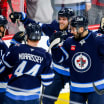Sharp-angle attacks:Ten of the 89 goals (11.2 percent) Grubauer allowed in the regular season involved post-integration tactics and technique. In the first round, two of 10 were of that variety, with a third coming off a low-high play, so attacking from sharp angles is not a bad idea. Calgary forward Andrew Mangiapane scored the first goal of the series on a net drive from just above the goal line that saw Grubauer push out from the reverse-VH position on his post rather than across, leaving him sprawled and unable get to the far post. Grubauer also tends to set up outside his post or use a traditional VH technique, with his lead pad upright against the post, on rush chances form sharp angles above the goal line. That delays his ability to get across to the far post and led to three wraparound goals during the regular season.
Rebound splits: Grubauer was noticeably above the tracked average (21.1 percent) for rebound goals. Last season it was 26 percent, and this season he gave up 27 of his 89 goals (30.3 percent) on rebound chances. There was only one against the Flames, but his tendency to extend into the splits on lateral plays and recoveries makes it important to have second-chance support around the net and make sure those opportunities are put back on net at least 11 inches off the ice.
Glove hitch gone: Grubauer's early playoff exit last season was tied in part to a bad glove-hand habit the Columbus Blue Jackets exploited. He would turn his glove down over his pad as he got set for a shot and it often left him playing catch up on high shots. That hitch is mostly gone, but Grubauer still tends to hold his glove at or below his hip. Though there seems to be a conscious effort to keep it higher, he is prone to getting passive with it when he moves,, something the Flames targeted.
Against the grain:Grubauer was beaten 23 times (25.8 percent) in the regular season on shots and plays that caught him moving the wrong way, well above the 16.9 percent average. He uses a narrow, upright stance and exceptional patience to make up for being on the small side at 6-foot-1 and shifts actively into shots, which can leave him susceptible to deflections and rebounds.




















